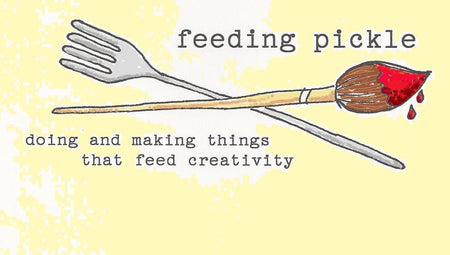It's that time of year when I go shopping with my eyes closed. Back to school items? Where? I can't see them behind my closed eyelids of denial.
Except when it comes to glue. I open my eyes then and...
I.buy.the.glue. Over and over we have enjoyed this project and the shining star is none other than the humble washable white school glue.

Batik painting (utilizing melted wax to creating designs that preserve the original fabric color before dye-ing the whole project) has always intrigued me. This project brings the art of batik painting to a level that even young Pickles can participate in and enjoy. And all you need is a few squirts of paint.
Here are the five simple steps:
1: squirt glue onto your fabric item of choice in any design you can imagine
2: allow glue to dry
3: spread watered down acrylic paints allllllllll over the fabric and dried glue designs
4: let it dry again
5: wash out the glue
Got it? It's so easy (albeit potentially messy), and it has such a rewarding outcome!
Here are a few more details to each step.
1. Always prep your workspace and fabric. Put down protection over your table/driveway/wherever you choose to do this project. If you choose to make an item like a shirt, put something in the shirt to prevent the glue from soaking through to the backside. Not paper or cardboard--a plastic board or a vinyl mat work better when it is time to release it from the glue. We have done t-shirts and pillow cases this way. For our single layer tent fabric, I just covered our workspace with heavy plastic and laid the fabric on top.
Pre-washing your cotton (yes, you want cotton for this project) fabric or shirts is recommended for best color absorption. Have I gotten t-shirts straight from the store and started right in? Absolutely! But the fabric will receive the paint best if it has been pre-washed.
NOW squirt that glue onto your fabric item of choice in any design you can imagine! Glue is funny in how it stretches and shrinks back and pools and wants to puddle. If you want more exact designs, use a super thin spread of glue on your project.
2. Allow the glue to dry. Allow at least 24 hours. If extra thick glue spots are still gummy in the middle, but dry on the edges, you can gently proceed to step three, being careful not to drag the wet glue along with the paint.

3. Spread watered down acrylic paints allllllll over the fabric and dried glue designs. (Remove the inner plastic if you want the paint to reach the backside now.) Realllllly water down those paints. The jar with the yellow paint in the bottom shows how much paint I used before I filled most of the rest of the jar with water. Have small drips of paint left in your old paint bottles? Just fill the bottle with water and shake it all up, then squirt onto the fabric. To spread paints, we have used foam brushes, large-ish craft paintbrushes, and we've gently poured the watered down paints. Have you noticed how free-spirited this is yet?

4. Let it dry again. I love to set our projects in the sunshine to speed up this patience-testing step (again!).

5. Wash out the glue. This is the "hardest" part. Translated slightly more tedious than the earlier steps, but easy enough for any Pickle who can rub fabric between their hands in a bucket of water. Depending on the amount of glue used, and if you have a HE washer, you don't really want to just throw this in the washer. Run cold water over your project and soak the glue back to softness. Use your hands to rub off as much glue as possible. (It's really fun to see the pictures revealed at this point!) Once you've got it pretty well washed off, give it a wash cycle with a few old towels for agitation/abrasion and then dry.

What are you going to make ?

Always be creative,
Marie Winfield

